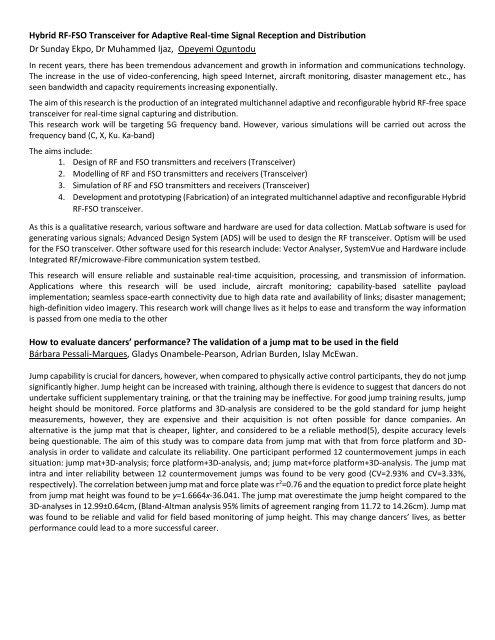Conference Programme FULL (1)
Create successful ePaper yourself
Turn your PDF publications into a flip-book with our unique Google optimized e-Paper software.
Hybrid RF-FSO Transceiver for Adaptive Real-time Signal Reception and Distribution<br />
Dr Sunday Ekpo, Dr Muhammed Ijaz, Opeyemi Oguntodu<br />
In recent years, there has been tremendous advancement and growth in information and communications technology.<br />
The increase in the use of video-conferencing, high speed Internet, aircraft monitoring, disaster management etc., has<br />
seen bandwidth and capacity requirements increasing exponentially.<br />
The aim of this research is the production of an integrated multichannel adaptive and reconfigurable hybrid RF-free space<br />
transceiver for real-time signal capturing and distribution.<br />
This research work will be targeting 5G frequency band. However, various simulations will be carried out across the<br />
frequency band (C, X, Ku. Ka-band)<br />
The aims include:<br />
1. Design of RF and FSO transmitters and receivers (Transceiver)<br />
2. Modelling of RF and FSO transmitters and receivers (Transceiver)<br />
3. Simulation of RF and FSO transmitters and receivers (Transceiver)<br />
4. Development and prototyping (Fabrication) of an integrated multichannel adaptive and reconfigurable Hybrid<br />
RF-FSO transceiver.<br />
As this is a qualitative research, various software and hardware are used for data collection. MatLab software is used for<br />
generating various signals; Advanced Design System (ADS) will be used to design the RF transceiver. Optism will be used<br />
for the FSO transceiver. Other software used for this research include: Vector Analyser, SystemVue and Hardware include<br />
Integrated RF/microwave-Fibre communication system testbed.<br />
This research will ensure reliable and sustainable real-time acquisition, processing, and transmission of information.<br />
Applications where this research will be used include, aircraft monitoring; capability-based satellite payload<br />
implementation; seamless space-earth connectivity due to high data rate and availability of links; disaster management;<br />
high-definition video imagery. This research work will change lives as it helps to ease and transform the way information<br />
is passed from one media to the other<br />
How to evaluate dancers’ performance? The validation of a jump mat to be used in the field<br />
Bárbara Pessali-Marques, Gladys Onambele-Pearson, Adrian Burden, Islay McEwan.<br />
Jump capability is crucial for dancers, however, when compared to physically active control participants, they do not jump<br />
significantly higher. Jump height can be increased with training, although there is evidence to suggest that dancers do not<br />
undertake sufficient supplementary training, or that the training may be ineffective. For good jump training results, jump<br />
height should be monitored. Force platforms and 3D-analysis are considered to be the gold standard for jump height<br />
measurements, however, they are expensive and their acquisition is not often possible for dance companies. An<br />
alternative is the jump mat that is cheaper, lighter, and considered to be a reliable method(5), despite accuracy levels<br />
being questionable. The aim of this study was to compare data from jump mat with that from force platform and 3Danalysis<br />
in order to validate and calculate its reliability. One participant performed 12 countermovement jumps in each<br />
situation: jump mat+3D-analysis; force platform+3D-analysis, and; jump mat+force platform+3D-analysis. The jump mat<br />
intra and inter reliability between 12 countermovement jumps was found to be very good (CV=2.93% and CV=3.33%,<br />
respectively). The correlation between jump mat and force plate was r 2 =0.76 and the equation to predict force plate height<br />
from jump mat height was found to be y=1.6664x-36.041. The jump mat overestimate the jump height compared to the<br />
3D-analyses in 12.99±0.64cm, (Bland-Altman analysis 95% limits of agreement ranging from 11.72 to 14.26cm). Jump mat<br />
was found to be reliable and valid for field based monitoring of jump height. This may change dancers’ lives, as better<br />
performance could lead to a more successful career.


